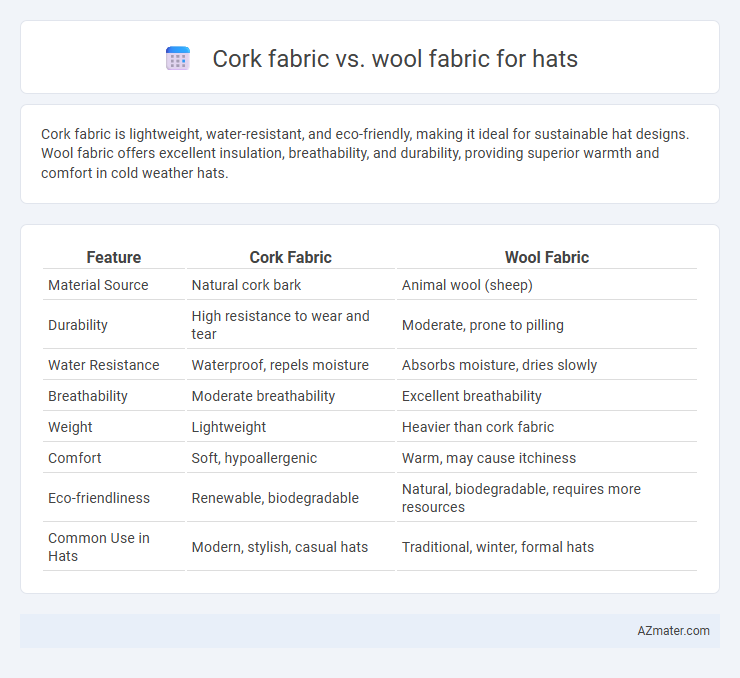Cork fabric is lightweight, water-resistant, and eco-friendly, making it ideal for sustainable hat designs. Wool fabric offers excellent insulation, breathability, and durability, providing superior warmth and comfort in cold weather hats.
Table of Comparison
| Feature | Cork Fabric | Wool Fabric |
|---|---|---|
| Material Source | Natural cork bark | Animal wool (sheep) |
| Durability | High resistance to wear and tear | Moderate, prone to pilling |
| Water Resistance | Waterproof, repels moisture | Absorbs moisture, dries slowly |
| Breathability | Moderate breathability | Excellent breathability |
| Weight | Lightweight | Heavier than cork fabric |
| Comfort | Soft, hypoallergenic | Warm, may cause itchiness |
| Eco-friendliness | Renewable, biodegradable | Natural, biodegradable, requires more resources |
| Common Use in Hats | Modern, stylish, casual hats | Traditional, winter, formal hats |
Introduction to Cork and Wool Fabrics
Cork fabric, derived from the bark of the cork oak tree, is a sustainable, lightweight, and water-resistant material commonly used in eco-friendly hat designs. Wool fabric, obtained from sheep fleece, offers excellent insulation, breathability, and durability, making it a traditional choice for warm, comfortable hats. Both materials provide unique benefits in hat-making, with cork emphasizing environmental sustainability and wool highlighting natural thermal properties.
Origins and Production Processes
Cork fabric originates from the bark of the cork oak tree, primarily harvested in Portugal and Spain through a sustainable process that allows the tree to regenerate its bark without harm. Wool fabric is produced from the fleece of sheep, with major production centers in Australia, New Zealand, and the UK, where shearing occurs annually to collect the fiber. Cork fabric involves a natural, eco-friendly process of boiling and pressing cork sheets, while wool undergoes cleaning, carding, and spinning to transform raw fleece into yarn suitable for hat making.
Sustainability and Environmental Impact
Cork fabric, derived from the renewable bark of cork oak trees, offers a sustainable and biodegradable alternative to traditional wool fabric, which requires intensive sheep farming with higher greenhouse gas emissions. Cork harvesting supports biodiversity and soil preservation, while wool production involves methane release and significant water consumption. Choosing cork fabric for hats minimizes environmental impact through eco-friendly sourcing and durability, making it a greener option compared to wool.
Physical Properties and Texture Comparison
Cork fabric offers a lightweight, water-resistant, and durable option for hats, featuring a smooth yet slightly textured surface that resists wear and stains. Wool fabric, known for its natural insulation and breathability, provides a soft, warm, and flexible texture that molds comfortably to the head. While cork is hypoallergenic and eco-friendly, wool excels in moisture-wicking and thermal regulation, making each fabric suited for different climatic and style preferences.
Comfort and Breathability
Cork fabric offers superior moisture resistance and lightweight comfort, making it ideal for hats used in humid conditions, while maintaining natural breathability due to its cellular structure. Wool fabric provides excellent insulation and breathability, adapting to temperature changes by wicking moisture away from the skin and regulating heat. Both materials enhance comfort, but cork excels in water resistance and durability, whereas wool delivers warmth and natural ventilation for all-day wear.
Durability and Longevity
Cork fabric offers exceptional durability and resistance to water, stains, and abrasion, making it an ideal choice for hats used in outdoor and wet conditions. Wool fabric, while naturally resilient and insulating, tends to wear down faster when exposed to moisture and rough environments, but it excels in breathability and warmth retention. Choosing between cork and wool for hats depends on the required lifespan and the specific durability needs based on environmental exposure.
Water Resistance and Weather Suitability
Cork fabric offers superior water resistance compared to wool, making it highly suitable for wet and rainy conditions when used in hats. Wool fabric excels in breathability and insulation, providing excellent warmth in cold, dry weather but tends to absorb moisture, reducing its effectiveness in heavy rain. Hats made from cork are ideal for outdoor activities in damp climates, while wool hats perform best in cooler, less humid environments.
Style and Aesthetic Appeal
Cork fabric offers a modern, eco-friendly aesthetic with a smooth, natural texture that creates a unique, minimalist look for hats. Wool fabric provides classic style and warmth, featuring rich textures and a timeless appeal that suits both casual and formal hats. The choice between cork and wool hinges on whether the focus is on sustainability and contemporary design or traditional elegance and comfort.
Maintenance and Care Instructions
Cork fabric hats require minimal maintenance, being water-resistant and easy to clean with a damp cloth, making them highly durable and mold-resistant. Wool fabric hats demand more careful care, needing gentle hand washing or dry cleaning to avoid shrinking and felting, alongside regular brushing to maintain their appearance. Both fabrics benefit from storing hats in a cool, dry place to preserve shape and longevity.
Choosing the Right Fabric for Your Hat
Cork fabric offers a lightweight, water-resistant option for hats, ideal for outdoor use and sustainability-conscious consumers, while wool fabric provides superior warmth, breathability, and natural moisture-wicking properties suited for colder climates. Choosing the right fabric depends on your primary needs: cork suits casual, eco-friendly hats with a unique texture, whereas wool is preferred for classic, durable, and insulating headwear. Consider factors like climate, intended use, and care requirements to ensure the hat fabric complements your lifestyle and comfort preferences.

Infographic: Cork fabric vs Wool fabric for Hat
 azmater.com
azmater.com